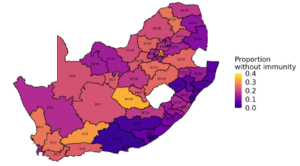Estimating population susceptibility to polio: Our efforts towards elimination
This World Polio Day we reflect on our ongoing polio modelling efforts – as we work towards a polio-free Africa.
Through collaboration with the National Institute for Communicable Diseases (NICD) and support of the Bill & Melinda Gates Foundation, results from our polio modelling work offer public health decision-makers more comprehensive insights to determine outbreak risks and evaluate vaccine program performance.
SACEMA’s Modelling and Analytics Response Team (SMART) developed a method to estimate population immunity to poliovirus, addressing concerns raised by the World Health Organization on the validity of using zero-dose children (ZDC) as a metric for susceptibility.

This map shows that, by the end of 2022, susceptibility to poliovirus type 2 among children under five varied widely across districts, ranging from as high as 30% in some districts to as low as 2% in others. Image: Vaccine.
Further work is being done to expand this project, including extending this method to older age groups and other poliovirus serotypes.
Our polio modelling research focuses on:
- Identifying high-risk regions in South Africa for poliovirus outbreaks
- Optimising wastewater surveillance for early polio detection
- Modelling susceptibility changes if oral polio vaccines had been phased out earlier
If you’ve got a a strong background in quantitative sciences, and are interested in a polio modelling project as part of a masters degree, SACEMA is offering scholarships for full-time study at Stellenbosch University.
Click here for application details. The application deadline is 31 October 2024.
Stay connected for the latest updates by following us on LinkedIn.



